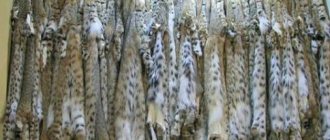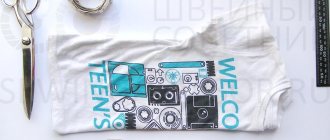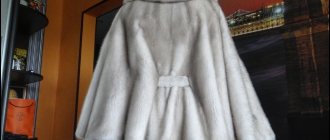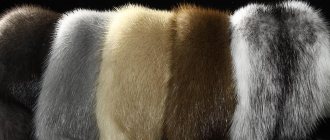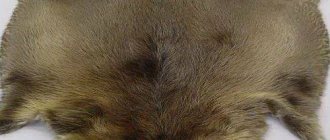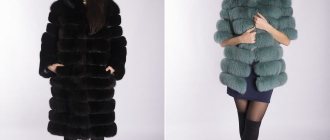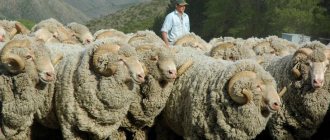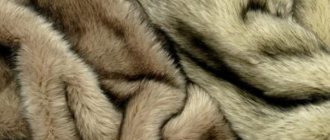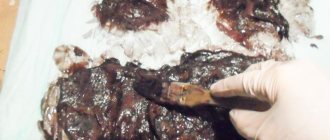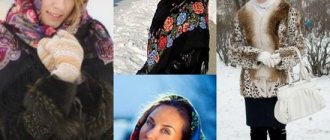Symbol of prosperity
Nowadays, fur products have the reputation of being the warmest outerwear. But if in the distant past people got “fur coats” at the cost of many lives, today this price is measured in several thousand, or even millions.
This is understandable, because since the time when society began to be divided into classes, furs have been considered a symbol of prosperity and wealth. In addition, a natural fur coat is incredibly warm and comfortable during the cold season. Although in the West, the wealthiest ladies wear their luxurious fur coats even in the warm season, sometimes under shoes or on a summer dress to flaunt their wealth!
Now women are increasingly trying to purchase natural fur coats, even without fabulous money. Sometimes they put it off for a long time. After all, everyone knows that a fur coat is much warmer than a down jacket, coat or sheepskin coat. And it lasts for quite a long time - sometimes up to 20 seasons! Therefore, such a purchase will definitely pay off over time. And the happy owner of a fur coat will not only acquire a high-quality and beautiful product, but will also receive a lot of positive emotions. But how to determine a high-quality and natural product? And most importantly, what is the warmest fur coat, what animal is it made from?
Difficult choice - which is warmer?
Mouton and mink . A mink coat traditionally emphasizes the high position of its owner. Outerwear made from it is elegant and spectacular, it has a high cost. More recently, mouton fur coats were not particularly popular. Sheepskin treated in a special way - mouton - did not have a very attractive appearance. Today, sheepskin, on the contrary, competes on a par with mink products. Mouton has higher thermal insulation properties than mink. Spectacular painting of a fur coat in bright colors looks very fashionable. The original cut makes it even more attractive. Mouton clothing has good thermal insulation, durability, resistance to moisture and easy care.
Difficult choice - which is warmer?
Beaver and mink . The skins of both animals have beautiful fur and high practicality. The advantage of a beaver coat is that it is more resistant to moisture, retains heat better and is easy to care for.
Fox . The thick wool of a fox fur coat retains heat better than anyone else. It has a bright color. Fur coats made from silver fox have a rich silver-black color. They are distinguished by their beautiful “appearance” and belong to the category of the best outerwear.
How to choose?
It is clear that when a representative of the fairer sex enters the “kingdom of fur”, she loses her head from the incredible abundance of models, styles and colors. Fur coats can be long, short, fitted or coated, with long sleeves or sleeveless. Diversity makes you think. Girls are thinking about which model to choose. What is the warmest fur coat? What is it made of?
The choice should depend not only on the beauty and price of the model. It is necessary to find out from the seller all the characteristics of the product. How long will the chosen product last a woman, how beautiful will it look on her? It all depends on the quality of fur used for the fur coat. The following tips will help you understand all the intricacies and correctly evaluate the naturalness of fur.
Tips for choosing
What are the warmest fur coats, what fur are they made from and what characteristics are important when buying them?
1. It is best to buy from a specialty store or salon that has been in this business for quite a long time and has earned a certain reputation and has good reviews. Such firms and organizations care too much about their “face” in the market to sell low-quality products. 2. Since there are no special devices that could characterize fur, the buyer will have to do this visually. A good one should be smooth and thick, and should not require constant fluffing and combing. It should not roll up and turn into “icicles”. The fur coat should look shiny and with some gloss. 3. Before putting on a fur coat for fitting, you must first iron the fur against the grain - the hairs should easily return to their place, without breaking or bending. If you squeeze the fur with your hand, it should also straighten without flaws and not stick together. 4. If all the characteristics are positive, you can try on the fur coat. It should not be too light in weight. Natural animal fur, of course, should not be weightless. But the weight of the fur coat should only be felt in the hands, and not on the body.
5. It would be useful to do the following experiment: taking the product in your hands, you need to shake it a little. Attention! If the fur coat “rattles” when shaken, then it is better to leave such a product in the store. This is a sign of low-quality, excessively hard, cheap material that they want to pass off as an expensive item. After all, a high-quality model should not crack or make pops or other sounds. 6. You definitely need to look at how the fur is combed. The fibers must lie strictly in one direction. A good quality product always contains uniform fur along its entire length. Any bald spots are unacceptable. 7. The last and, perhaps, the most important way to determine the quality of a fur coat is to squeeze a bunch of fur with your fingers and quite sharply pull it towards you. If the fibers remain in place and not in your hand, you can safely buy such a fur coat, it is of high quality.
True, such an experiment must be carried out thoughtfully. It's unlikely that any seller will like it. On the other hand, if the fur coat does not pass the test, the buyer will know that it is not worth purchasing, and the seller will have nothing to object to such an argument.
Choosing a quality fur coat
So, you have decided to get the best fur coat in the world, which means that the dream product should be warm, wearable, skillfully sewn, and the material itself should be perfectly crafted. So, the main question is which fur to choose? No, not only. The fur coat should fit perfectly, taking into account the characteristics of the figure. However, in order:
Probable service life of fur
The choice of fur from which a fur coat is made is directly related to its wear resistance and durability. We have prepared a comparative table of furs , which shows the most important characteristics of the most popular types. Using the table, it is easy to determine which product will last the optimal long time, will be guaranteed to provide warmth and be comfortable to wear.
| TYPE OF FUR | SEASONS | WEARABILITY | HEAT RESISTANCE | WEIGHT |
| Otter unplucked/plucked | 20/18 | 100/95% | high | heavy |
| Wolverine | 20 | 100% | high | average |
| Brown and black bear | 19 | 95% | high | heavy |
| River beaver unplucked/plucked | 18 | 90/85% | high/moderate | heavy |
| Natural/dyed sable | 16 | 80/65% | high | heavy |
| Natural /colored raccoon | 10 | 75/60% | moderate+ | heavy |
| Mink natural/dyed | 10 | 70/55% | moderate+ | average |
| Soft marten natural/dyed. | 7 | 65/50% | moderate | average |
| Sheepskin/mouton | 7 | 65/55% | high | average |
| Karakul/karakulcha | 6 | 50/15% | moderate/low | average |
| Arctic fox blue/white | 7 | 60/45% | high | average |
| Wolf natural/dyed | 6 | 60/40% | high | heavy |
| Mountain marten nature . | 5 | 45% | moderate | average |
| Muskrat natural/colored | 5 | 45/35% | moderate | heavy |
| Nutria unplucked/plucked. | 5 | 40/25% | moderate | heavy |
| Fox natural/dyed | 5 | 40/35% | high | heavy |
| Lynx natural/dyed | 5 | 30/20% | high | average |
| Natural/dyed protein | 4 | 27/20% | moderate | light |
| Silver fox | 4 | 25% | high | average |
| Ermine | 4 | 25% | moderate | average |
| Chinchilla | 2 | 15% | moderate | light |
| Rabbit | 2 | 10% | low | light |
| Brown hare | 1 | 5% | moderate | average |
IMPORTANT!
Quality and pricing
- Style (length, cut, skin consumption). Everything is simple here - a long and flared fur coat requires more skins for production than a short and straight one, therefore, the price increases with every centimeter.
- Quality of workmanship . The determining factors here will be the same density of fur, the absence of creases, the neatness and evenness of the seams.
- Fur quality (shine, softness) Thick down, long, soft to the touch and unbreakable hairs, which, when stroked in the opposite direction, quickly return to their original appearance.
- Sewing technology (dissolving, plates) Conscientiously produced dissolving (cutting the skins into strips diagonally, soaking and stretching them, followed by stitching along the bias) will cost more than sewing from solid plates. But the wearability of such a product is an order of magnitude higher, and visually the dissolution is unrivaled.
Determining the authenticity of fur
A sure way to avoid fraud when buying a fur coat:
- make a purchase in a specialized store with a good reputation
- ask the seller for a certificate of authenticity
If you are denied this, for one reason or another, don’t hesitate to turn around and leave - it’s better not to risk it. We want to choose a quality fur coat for more than just one day, don’t we?
Perhaps having a certificate is not enough of a guarantee for you? Well, a few tips below will help you determine the authenticity of the most popular types of fur.
Mink is the leader in the number of fakes
The very popular and valuable mink fur is often passed off as a specially bred and shorn rabbit or marmot. Falsification can be revealed by simple stroking: the mink is somewhat stiffer and more elastic - the fur instantly absorbs the shock. A rabbit is much softer and if you run your hand against the fur, the hairs will not return to their original shape.
In addition, a genuine mink has dense and even guard hair and undercoat, while a rabbit's guard hair is uneven and slightly prickly if it has been clipped.
How to choose a beaver fur coat
An unplucked beaver is difficult to fake - it is too recognizable, but a shorn and plucked beaver is often replaced with the fur of a cheaper nutria or ferret.
Plucked beaver, due to the complicated plucking technology, is more expensive and wears easier and lasts longer. The most important thing here is to distinguish it from fakes. And this is not difficult to do, just run your hand against the fur and feel a light and sharp tingling sensation in the hair. This characteristic feature is inherent only to this fur.
Another defining feature is weight. Beaver fur cannot be called light, due to the dense down that does not allow air to pass through, among other things. Blow on the fur, and if the skin is not visible, the sign of authenticity is obvious.
Finally, the beaver belongs to the family of aquatic rodents, and not only is it not afraid of moisture, but under its influence the fur becomes even fluffier and more luxuriant. Of course, only a crazy seller will allow you to pour water on your fur coat to check, but the very first test with wet snow will convince you of the correctness of the purchase.
Silver fox or fox dog?
IMPORTANT!
A genuine silver fox is distinguished not only by fur that is uniform in length and density, but also by an exclusive three-color color. The palette of shades is as follows: bottom - pearl gray, middle - milky white, top - pearl black. And nothing else. This color cannot be falsified.
Mouton - the game is worth the candle!
The most popular and affordable Russian fur is often replaced by careless manufacturers with low-grade analogues, or, even worse, with faux fur. How to choose the right quality mouton fur coat?
You can diagnose naturalness by the reverse side - the flesh should look like tanned leather, which in essence it is, in contrast to the fabric base on faux fur. The quality of the product is easily determined by squeezing and quickly releasing the fur in the hand. A good mouton straightens out quickly and its hairs do not stick together. The seams should be smooth and tactile. If they cannot be felt, it means that gluing was used instead of seams, and this is a sign of counterfeit. You should also be sure to check the quality of the color of the mouton by running a white cloth over the fur - there should be no traces of paint left on it.
IMPORTANT!
If the humidity is high...
Any fur product should not only be of high quality and last a long time, but also be warm enough to warm its owner in cold weather. That’s why an equally pressing question arises: “Which fur coat is the warmest and most practical?” Feedback from women is varied.
It is clear that every owner of an expensive product wants her fur coat to last as long as possible and keep her warm for more than one winter. It often happens that an unscrupulous manufacturer, in order to save material when sewing, resorts to the blasphemous method of stretching precious skins. In this case, the fur loses its properties and also wears out quickly. Such a fur coat loses its chic appearance especially quickly in areas with high humidity. In such regions, even the highest quality goods quickly wear out, and there is nothing to talk about second-class goods. So what are the warmest fur coats? What kind of fur is best to choose for this region? To prevent your favorite item from deteriorating under the influence of a humid climate, you need to choose models made of moisture-resistant fur - beaver, wolverine, nutria, fur seal, otter. In addition, they are quite comfortable.
Wearability of a fur coat
The cost of fur products does not allow most women to change them every season. Therefore, it is important that the chosen fur coat is practical and serves its owner for as long as possible, while maintaining an attractive appearance.
Wearability is one of the properties of fur. It depends on several factors:
- hair wear resistance;
- bond strength between leather tissue and hair;
- wear resistance of leather fabric;
- dyeing;
- dressing;
- storage conditions.
The durability of otter fur is considered to be 100%. This is 20 seasons - the largest figure. The wearability of other types of fur is calculated in relation to this figure. Based on wear data, you can roughly calculate how many seasons a fur coat will last. Fur manufacturers provide the following data:
The durability of a fur product is largely determined not only by the natural properties of the skin, but also by the skill of the manufacturer and the processing method. This figure will be higher if the product has “winter” fur. It has a higher density and thick down. In animals during the molting period, the strength of the bond between the flesh and the hair decreases, so such skins are of low quality.
Fur coloring reduces wearability by 10-20%, and cutting, on the contrary, increases wearability by 20-40%. Therefore, long-haired fur is sometimes trimmed to prevent breakage and matting. But sheared fur of ermine, rabbit, and gopher warms worse.
The warmest fur coats. What are they made of?
So, we figured out how to recognize a high-quality fur item. Now let's talk about something else. What kind of fur is the warmest fur coat and how to choose it correctly?
As already mentioned, the main condition when choosing not only a fur coat, but also any outerwear is that it should be comfortable, durable and warm. This advice is especially relevant for residents of the northern regions. There are fierce colds that rule there, from which it is easy to hide in a fluffy warm “darling”. Such conditions are the best test for any fur coat.
- So, what products will best protect you from winds and snowstorms? Which fur coats are the warmest? Of course, this is the fur of blue or white arctic fox, sheepskin (mouton coat), small chinchilla, red fox, “royal” sable, classic short-haired mink, astrakhan fur, raccoon, beaver, fur seal (seal) and even domestic nutria. It is the furs of these animals that are especially relevant at the present time. Fur coats made from artificial materials are inevitably receding into the background.
- Once again, we need to remind you that for humid air it is necessary to choose a fur coat from the fur of animals that themselves live in similar conditions. These are mainly waterfowl species - beaver, fur seal, wolverine, otter, nutria.
- The least warm, but still very expensive, are products made from the most luxurious ermine, rare marmot and cheaper sheared rabbit. And this is no coincidence. Long fur is the best way to keep you warm in winter. Therefore, the shorn one is the coldest. Such fur coats are most often chosen by fashionistas who buy fur “for beauty.” You can only show off in such a fur coat in the car or at a reception.
Fur and its thermal properties
Fur coats made from natural fur do not retain heat equally. If the coat is thick and long, and the hair is elastic, be sure that you will not freeze in a fur coat. There are air bubbles in the structure of the hair, and they determine the heat-protective properties of the fur. Its looseness and flesh also affect this indicator.
When processing the skin, the inner skin is stretched (the weight of the fur coat decreases, the hairs become sparser). This leads to a decrease in the heat-protective properties of the fur coat.
Animal skins are divided according to the degree of heat conservation as follows:
- Products made from fox, sable, mouton and wolf provide the best warmth.
- the average for fur coats made from chinchilla, beaver, arctic fox and mink;
- The coolest clothing is made from the skins of rabbits and goats.
A product with long hair and thick down will retain heat even in severe cold. High-quality wool should be shiny and have the same length of hairs. Each animal has its own fur length. Wolverine, raccoon and fox have a length of 4 cm, muskrat and sable - from 2.5 to 4 cm, mink fur - up to 2.5 cm. It is very easy to check the quality of the down, blow lightly on the fur surface and you will see how dense it is and thick.
The arctic fox's hair is long. It allows him to winter comfortably even at temperatures of -60 degrees. Because of this, arctic fox products are among the warmest. The fur of these animals is beautiful and pleasant to the touch. Women in fur coats made from blue fox look impressive. Their cost is quite high.
Fur and its thermal properties
If the fur coat will be worn in conditions of wet snow and rain, in humid air and not very severe frosts, take a closer look at products made from the skins of waterfowl mammals - beaver, nutria, otter.
The skins of sable, arctic fox and fox have the softest fur to the touch.
Fur coats made from chinchilla or ermine do not have a high level of thermal protection. To give a very small volume, they can be sewn without insulation. These models are elegant, they emphasize the slimness of their owners.
When choosing a fur coat for a harsh climate, it would be better to buy a product made from uncut animal wool. Fur coats made from whole pieces of skin also retain heat better. Unlike skins assembled from small parts. Reindeer and muton fur coats have the best thermal protection, as do sable and fox fur coats.
Surprisingly, the fur of females is less warm than that of animals of the opposite sex. Although it is quite difficult to confirm or deny this.
The best
As a result, you can easily say which fur is the warmest fur coat.
These are rightfully considered the furs of sable and mouton. In second place are the Arctic fox, astrakhan fur, mink, chinchilla, beaver, nutria and fur seal. What animal is the warmest fur coat in the world made from? From a fox. Its fur will keep you warm in the most severe frosts.
We decided on what kind of fur is used when sewing the warmest fur coat. What are the coldest models made from? From marmot and ermine.
When it comes to durability and longevity, the most durable ones are otter fur coats. Raccoons, beavers, minks and arctic foxes are slightly inferior to it.
More budget models made from rabbit, accordingly, do not last long and require constant care, additional cleaning and very careful wear.
Cheap cannot be quality
The most important thing: do not buy a cheap fur coat. Then it’s better to refuse the purchase altogether. After all, high-quality fur cannot be cheap. You should not fall for the seller’s “sweet tales” that this is “a high-quality collection, but discounted due to the fact that it is from last season.” No manufacturer will allow the price of an excellent product to be reduced too much, even if the model is no longer in fashion. Therefore, you should not spare money when buying the best. After all, as the famous proverb says: “Only the rich buy cheap things.”
